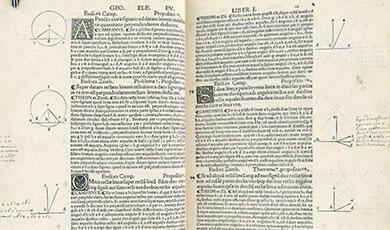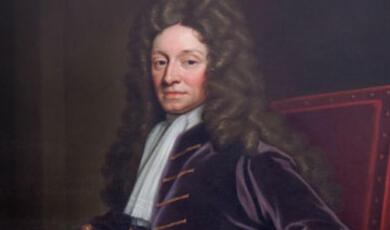6 May 2011
Early Mathematics Day
The Archimedes Codex
Reviel Netz
The Archimedes Palimpsest really is a phenomenal thing, because Archimedes was a phenomenal man in a very precise and unique way. Studying the Palimpsest, you can appreciate a certain conceptual subtlety that becomes integral to the overall history of mathematics, and which makes every last detail that we tease out of the text extraordinarily meaningful. In this lecture, I intend to uncover the Palimpsest to you. I will race through a few of those subtle things that we have discovered that are of rich significance. I shall start with the two major things that are covered in my book – The Archimedes Codex – and then move onto two, more recent issues, not covered in the book, but which will give you a sense of the kind of project that I have been working on.
Let me briefly acquaint you with the Palimpsest. This is what it looks like today. You can see the mould, the purple marks. You can see that it has suffered fire damage, though not significantly. You can see that it is harmed in all sorts of ways. What you cannot see here at all, by the way, is Archimedes. The writing that you see here is a Greek prayer book.
In order to preserve a book like this, you take the book apart and keep each page separately. We can look at photos taken of the Palimpsest pages from 1906, which reveal information that can no longer be seen in photographs taken today. However, there are other techniques that we can use nowadays. We can use technology to bring out a powerful contrast between the overlaying and underlying texts, which allows us to see the latter in greater detail.
Perhaps the most spectacular technique that we have been using is x-ray fluorescence. We bombard the page with x-ray waves and then count the florescence in this way, because it reacts differently to different elements in the page’s surface. The ink includes iron, which the parchment, the animal skin, does not include in any significant amount at all, so this provides a certain contrast. The image produced is not a visual image at all but a physical image. It is an iron count of the manuscript. The technique is very interesting and powerful and gives you information that you cannot see otherwise. It also creates an extra complication because, these being x-rays, they also show us the other side. So, instead of a normal palimpsest, where you see two layers, we now see four layers, which we need to separate as we are reading. That takes some work, but it can be done.
Indeed, this technique has allowed us to read the very first page of the manuscript, which is otherwise completely illegible. This was especially important because, being the very first page, it contains the prayer-book dedication. Thanks to this x-ray fluorescence, we found that the book was apparently dedicated in Jerusalem in 1229.
So, what are we looking at? It is a manuscript of Archimedes. It is one of the medieval copies made of the works of Archimedes. It was made, apparently, in the 10th Century AD. It was not used much at all. There are no marginalia or corrections to the various errors, so it fell quickly into disuse. It was always just a collectors’ item, nothing else. Quite naturally and appropriately, in 1229 it was recycled, the pages taken out, torn, rotated, scraped and written over as a prayer book.
There were other medieval copies of the works of Archimedes produced, most of them lost, but one of them made its way to Italy. It was there from the 13th century onwards, but it was available from the 15th century. It was often copied in the 15th Century, and you could say that, in a sense, it was the manuscript that sparked the scientific revolution.
With this manuscript, we have certain works that we do not have elsewhere. This is a manuscript that failed to spark the scientific revolution. It was not there to spark the scientific revolution. The manuscript that did got lost, so this remains the only medieval copy we have of the works of Archimedes.
It was finally identified as containing works by Archimedes in 1906 by Johan Ludvig Heiberg, the great Danish philologer. Heiberg did an incredible job of editing the text from the material he had, from photographs of the manuscript when it was in a better shape.
It was promptly stolen, shortly after Heiberg worked on it, in the aftermath of the First World War. It was once again hidden from view. We did not know where it had been all this while. And then, finally, in 1998, it was sold for a relative bargain, for $2 million in an auction in New York. Since then, it was given for preservation and for scholarship, housed at the Walters Art Museum at Baltimore where we have been working on it. It is now going back to its owner, much enhanced in value – a worthy investment, I would say.
There is going to be a facsimile and transcription volume, together with an entire volume of commentary and study, which will appear in the autumn. In a sense, however, all of this has already been made available online.
I would now like to race through some of the breakthroughs that we have achieved. Perhaps the most important discovery is that of The Method, a work that is preserved only in the Palimpsest. Archimedes measures, among other things, the volume of the object created by passing a slanted plane through a cylinder.
It resembles a fingernail and it is shown here encased in a prism because, very remarkably, this very curved object is exactly one-sixth of the perfectly rectilinear prism that encloses it. That is a result that Archimedes really liked. It is a great achievement. He does this by taking this figure and the prism that encloses it and passing essentially infinite arbitrary planes through it. We are concentrating on two-dimensional images. There is a triangle set up by each of these arbitrary planes - a triangle which is within the prism, a triangle which is within the cylinder - and there are also lines at the base of the cylinder - lines associated with the rectangle, lines associated with the circle. Archimedes also constructs an ad hoc parabola for the sake of the construction and for the geometrical work that he is doing with it.
We discovered something completely unexpected about the geometrical work. Essentially, Archimedes relies on claims such as ‘the triangles in the prism are equal in number to the lines in the rectangle’. It turns out that he finds certain proportions between triangles, lines, and then sums up the proportions to find that the proportion of the triangular prism to the cylindrical object is a certain ratio. He does a certain summation from infinitely many ratios to one ratio that encompasses all the infinitely many ratios, and for this purpose, he relies on certain theorems of summations of ratios and certain equalities. The triangles in the prism are equal in number to the lines in the rectangle, the numbers in question obviously being infinite. There is no question at all that this is how Archimedes envisages it. We are not talking about thin wedges, we are talking about actual two-dimensional planes.
This is very exciting from the perspective of the history of mathematics, where we have all been taught, and indeed, all have been teaching (myself included) that the Greeks never used infinity, because they had all sorts of logical problems with the concept. On the basis of this discovery in the work of Archimedes, we should be very sceptical about saying that ‘The Greeks did so-and-so’. I think when people say ‘the Greeks’, usually what they mean is Aristotle. That is the way our understanding of antiquity works - we take certain economical authors, find certain tendencies in them, and then try to generalise from those views, to apply those views to the Greeks as a whole. It is important to see that the Greeks are really the Greeks – there are plenty of Greeks, and they did very different things, which was essential to their culture. It was a culture of polemic debate and not a culture of consensus, so we should not be surprised to see Archimedes doing something that Aristotle perhaps would not have approved of.
Here is all that remains of Archimedes’ Stomachion. The beginning is very difficult to read, and so is the end – it is the actual end of the book. It is the end of the prayer book and it was the end of the original book that was produced in the 10th Century AD, and ends do not fare well, generally speaking. Because you touch the ends of books with your hands, you expose them more and they tend to get ruined much faster. The end is also closer to the cover, which is made of leather, a very hostile sort of organism that parchment does not like. So the end really was in a terrible condition in 1229, which explains why the person making the Palimpsest made the choice to throw away the last few pages, seeing as they would not survive should he try scraping them again. Of the Stomachion, they used only this. So what did he use? He used the introduction. That is all we have of the Stomachion and in very bad shape, so Heiberg really could not read much of it in 1906.
So, what is the situation? The situation is that we do not really know what the Stomachion was, but we have a few more hints than Heiberg had because now we have read it. Now we know what is written in this fragmentary text. We also know, from other sources, that there was a game in antiquity called Stomachion, which involved various pieces that could be fitted together, a tangram puzzle. Archimedes speaks in a way which makes it clear that he is not inventing anything; he is talking about something that is already known. From what I read in the introduction, I think Archimedes is telling us that the point of doing the treatise is the fact that there are many ways of putting the puzzle together and the point is to count them. There many different types of substitutions and rotations, I think, so he might be aware of those things.
I am not a mathematician myself, rather an historian of mathematics, so I did not try to calculate this myself. Mathematicians started working on this problem and arrived at this solution. So here is a solution that was arrived at:
That is actually just a set of canonical answers, out of which one can multiply more through basic symmetries. 536 basic solutions, which, through the obvious symmetries of a square, become 17,512 solutions to the problem of putting together the square of the “Stomachion.” This is momentarily surprising, but once you start thinking about it, it becomes obvious there are quite a few substitutions there, and they interact in interesting ways. So some of them will cancel out each other and will rule out others, so it is not a matter of simply counting how many substitutions there are and multiplying them. There is an interesting puzzle there, but one that can be solved through very elementary techniques. Essentially, it is something that you just count, rather than developing a theory for. Perhaps this is what Archimedes could have come up with, something such as this, expressed in a verbal form. Once again, that is very exciting.
In the previous case, we had Archimedes doing something which we thought the Greeks were not doing. Here, Archimedes is doing something that we thought Archimedes was not doing - we do not normally think of Archimedes as doing combinatorics. But there is something very deeply playful, very deeply counting-based, in what Archimedes is doing here. Actually, when you start looking at the corpus of Archimedes, you find that, once again, it is a matter of our modern perceptions. I think the modern perception is to take Archimedes as the person who did the measurement of the sphere and the cylinder, the quadrature of the parabola, the author of this tradition that gives rise to the calculus, the person thinking seriously about problems in the measurement of curved figures in a way that gives rise to integration. That is how we think about him. But really, he did a very great variety of things, and this actually seems to be the essence of what he was doing. The Greeks in general engaged in this polemical society of debate, and Archimedes in particular comes from this culture of the Hellenistic world where one is especially interested in variety, in trying to do many things together, of trying to do things that, in a single work, brings together many different strands. I think we understand Archimedes and his culture a bit better by thinking about works such as the Stomachion and not just the canonical works.
I now want to talk about things which are not in the book. However, before I do so, I want to say a word about diagrams. Diagrams are extremely important, obviously, for understanding the way Archimedes was thinking, for understanding science in general, but diagrams were not studied at all by people such as Heiberg. For one thing, they had so much to do in recovering the text, but there was also a certain bias perhaps against the use of diagrams for mathematics purposes. It is clear to us today that diagrams were a real part of the logic of Greek mathematics, so it is very important to recover them in our work.
Let us turn to On Floating Bodies. I have mentioned that Archimedes leads to the calculus. Archimedes also leads to mathematical physics. Somehow, the combination of the calculus and mathematical physics was really essential to the way in which the scientific revolution was shaped and modern science was born. Archimedes looked at the mathematics of objects in water. What does he do primarily? We tend to think of Archimedes’ hydrostatics as fundamentally a study in achieving the law of buoyancy, and that is certainly a very remarkable achievement, through using absolute principles – just a single postulate, and you get the law of buoyancy. That is it. But actually, for Archimedes, that is just a stepping stone. What he does primarily, in what is the most difficult and sophisticated part of his entire work, is to look at various objects, in particular segments of conoids of revolutions (objects you get by taking conic sections and turning them about their axes), and consider the conditions of their stability immersed in a liquid. So, if you have a very long hyperboloid, it will lose its stability in different angles. What is the stability when the base is inside the liquid? What is the stability when the base just touches the liquid? He goes through all those cases, which give rise to very complicated applications of geometrical principles and physical principles at the same time, again demonstrating this interest in variety.
This begins with a study of the segment of the sphere immersed in liquid - this is where he sets the ground for this study. We have, as is typical, a planar and fairly schematic picture. We have a segment of a sphere, immersed in the water. It is immersed in the entire ocean. For the sake of the exercise, we imagine that the entire Earth is made just of water, so the ocean is the Earth, and of course everyone knows that the Earth is spherical, so there is no problem describing the Earth as a circle as well. The object is rather big, relative to the Earth. It does not really matter, but it makes the picture easier to draw. So, we are looking at a segment of a sphere immersed in the Earth. This is the picture drawn by Heiberg in his modern edition, so it will be useful to see that that is not actually what we see in the ancient diagram.
This is my version of the ancient diagram, which we can compare with the modern drawing:
There is an immediate noticeable difference, involving the position of the point represented here by the lambda. In the ancient diagram, this is very obviously not at the centre. I must tell you that this point stands for the centre of the Earth. This is how the proposition works. We can begin to see what Heiberg is doing, but we begin to wonder why the ancient diagram is different. What function could it serve?
As I said, Archimedes studies stability. He says that a segment of a sphere will be stable under certain conditions. How does he claim this? He considers alternative arrangements and argues for the instability in them.
Here is an example of a diagram from Euclid. This is Euclid book three, proposition 10. At the top, you can see a drawing by Heiberg, and below it, six different ancient diagrams, all quite similar to each other, and all quite different from the one that Heiberg drew. The ancient diagrams have much more elongated objects in the middle.
What is this proposition about? This is a proposition that proves that two circles do not intersect each other at more than two points. How does Euclid go about it? Through a proof by contradiction. Assume that two circles can intersect each other at more than two points - in this case at four points - and we get an impossibility. The ancient diagram makes a very different choice from Heiberg. Heiberg draws it in the way that it appears most plausible. He draws two ‘circles’ that are as near to circles as one can draw them under the conditions. Euclid obviously made the opposite choice. He made a choice to draw circles that are very obviously not circles. The other ‘circle’, the one that is supposed to intersect the circle at four points, is very elongated. We can see that two circles cannot intersect each other in more than two points.
Here is another, very closely related, example, once again from Archimedes. This is proposition 13. Archimedes makes a very similar claim: he claims a tangent line touches a spiral at no more than one point. If a line is a tangent to a spiral, it will not touch it again after the point at which it has touched it in, and for the sake of this proposition, he does something which Heiberg does not reproduce. Heiberg does not reproduce this diagram – he has his own diagrams. He has a diagram where the line, the tangent, touches first at gamma and then at etta, being broken very powerfully in the middle. You emphasise visually the impossibility of the impossible case, in a proof based on impossibility, and I would argue that this is what happens here.
When Archimedes wants to show us the instability of a certain case, he shows this by making the case appear impossible. This suggests something very profound about the way Archimedes thinks about mathematical physics. Archimedes is actually misleading us. He says, “…for if possible, let the segment of a sphere be in that position.” But of course, the segment of sphere can be in that position. The unstable position is not impossible. It is merely unstable, and this has important consequences. The logic of possibility and impossibility has certain rules that allow one to work with it. The logic of impossibility leads us from one case to its complementary case in an instantaneous fashion. We tend to do the same in physics. From a not stable disposition, we do not automatically claim that the complementary position is stable. We need a physical path. Archimedes never provides us with a physical path and, for all we know, it cannot be achieved. The statement that an object will reach its stability from its instability is essentially based on exporting the logic of possibility and impossibility and mapping it onto the logic of stability and instability. That is not simply an example of what Archimedes is doing in floating bodies. I think it is the key to the way in which he constructs his mathematical physics. He constructs his mathematical physics by taking physical objects and putting them, not purely in the geometrical space of three-dimensions and lines and surfaces, but also putting them in a space defined by the logic of pure geometry. That is how mathematical physics is constructed. I think that this diagram provides us with an important clue about the way Archimedes thinks about physics. That is an example of one thing that we can learn, or at least debate, when looking at the diagrams in the Palimpsest.
Finally, let me give you a small reading from the end of the Palimpsest, which is my favourite. It consists of three simple lines, all of which were previously proved by Euclid. That is very exciting because, if you a historian of mathematics, you care about the relationship between Archimedes and Euclid because we do not really know when Euclid lived. We know when Archimedes lived because we have historical evidence of his death with an actual date, which essentially forms the foundation of all our chronology of Greek mathematics. If we could know that Euclid is before Archimedes, this would be very useful.
This comes from Sphere and Cylinder, in which Archimedes, midway through, suddenly makes a few citations of previous results concerning cones and cylinders, and says that these were proved. Sphere and Cylinder exists in the other manuscript – the manuscript that got into Italy and sparked the scientific revolution and then got lost. It is there, so we have evidence for this manuscript. That manuscript has very similar text for Sphere and Cylinder in general. In this case, the other manuscript states that these problems were all proved by previous mathematicians. This gives us a different reading, and we want to know which is the correct reading.
Proclus, in his commentary to Euclid’s Elements, says “…and then came Euclid”. We know that Euclid came about then because we know that he is earlier than Archimedes, because Archimedes refers to him. That is interesting.
There is another moment in Sphere and Cylinder where both manuscripts state: “…and this can be shown the second proposition of the first book of Euclid’s Elements”. Maybe this is what Proclus is referring to and we have just added a small thing. However, that other place is very clearly wrong. It is a very silly statement, certainly not in the original text. This gives us many different options. Perhaps this new reading, that all of this was proved by Euclid, is a mistake made by this scribe in the Middle Ages and that is all there is to it, and the correct reading is in the other manuscript, and the real text that Proclus also knew also said this was proved by past mathematicians and all Proclus referred to was the reading that we knew already - or perhaps the reading that we always thought Proclus was referring to. Perhaps, ultimately, this could even be the correct reading and it could be the correct reading by Archimedes, in which case, not only does it tell us what Proclus was thinking about, but it also tells us that Euclid was earlier than Archimedes. The range of options here is very wide, and as with the diagrams, this opens up the sense of the possible debate that historical documents can lead to, and in general, what is involved in the study of historical documents. It should also give you a sense of why working with this manuscript was not only such an important piece of work, because of all the consequences it has, but also such a fun piece of work to do.
Thank you.
© Professor Reviel Netz, 2011


 Login
Login







